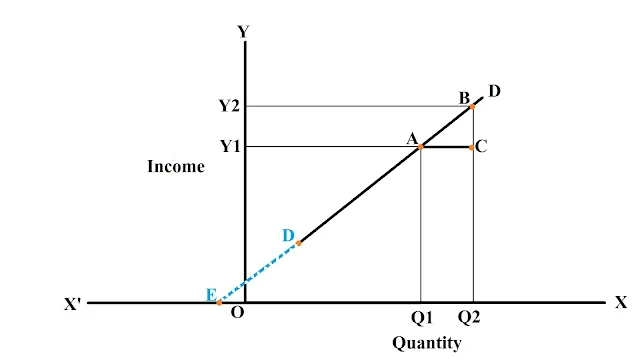Measurement of Income Elasticity of Demand
1. Percentage Method
According to the percentage method, the income elasticity of demand is measured by dividing the percentage change in demand by the percentage change in income.
Ey =Percentage change in Demand/ Percentage Change in Income
∆Q = change in quantity demanded
∆Y = change in income
Y = Initial income
Q = initial quantity demanded
∆Y = change in income
Y = Initial income
Q = initial quantity demanded
2. Arc Method
The coefficient of income elasticity of demand between two points on an income demand curve is called arc elasticity of income demand. This method is used when there is a big change in income and demand. According to this method, income elasticity of the demand is the coefficient of average between two points of the income demand curve.3. Point method
The income demand curve slopes upward in the case of normal goods. But it slopes downward in the case of inferior goods. Here, we will measure income elasticity at a point of the income demand curve, which slopes upward from left to right. The income demand curve may be linear or nonlinear. We measure point elasticity in both linear and non-linear income demand curves.i. Point elasticity on a linear income demand curve
Income elasticity of demand is the ratio of percentage change in demand and percentage change in income. Therefore, income elasticity of demand at a point is given as
Ey = (ΔQ/ΔY) x Y/Q
Where;
Ey = Coefficient of Income elasticity of demand
ΔQ = Change in Quantity demanded
ΔY = Change in Income level
Y = Initial Income
Q = Initial Quantity Demanded
a. If the income demand curve cuts Y-axis or meets the x-axis to the left of the origin, the income elasticity will be relatively elastic. i.e, Ey > 1.
In the above figure, the DD curve represents a linear income demand curve. Let us suppose, we have to measure the income elasticity of demand at point A of the linear income demand curve DD.
Now,
Ey = (ΔQ/ΔY) x Y/Q
or, Ey = (Q1Q2/Y1Y2) x (OY1/OQ1)
∴ Ey = (AC/BC) x (OY1/OQ1)
b. If the income demand curve passes through the origin, income elasticity of demand will be unitary. i.e; Ey = 1
Ey at Point A = OQ1/OA = OQ1/OQ1
= 1
In the above figure, DD is the non-linear income demand curve. There are three points A, B, and C along the demand curve DD. The straight line MN is tangent at point A; the straight line OK is tangent at point B and the straight line LP is tangent at point C.
Therefore,
It also shows that at the different points of a non-linear income-demand curve, there are different degrees of income elasticity of demand.
c. If the income demand curve meets the x-axis at any point that is right to the origin, the income elasticity of demand will be relatively inelastic. i.e, Ey < 1.
= <1 (∵ BQ1 < OQ1)
ii. Income elasticity of demand at a point on a non-linear income demand curve
If the demand curve is non-linear, then the income elasticity of demand at a point can be computed by drawing a tangent line to that point and apply the same formula that is used in the case of a linear demand curve.
In the above figure, DD is the non-linear income demand curve. There are three points A, B, and C along the demand curve DD. The straight line MN is tangent at point A; the straight line OK is tangent at point B and the straight line LP is tangent at point C.
Therefore,
Ey at B = OQ2/OQ2 = 1 (∵OQ2 = OQ2)
Ey at A = MQ1/OQ1 > 1 (∵MQ1 > OQ1)
Ey at C = LQ3/OQ3 < 1 (∵LQ3 < OQ3)
It also shows that at the different points of a non-linear income-demand curve, there are different degrees of income elasticity of demand.








.jpeg)
0 Comments
If this article has helped you, please leave a comment.